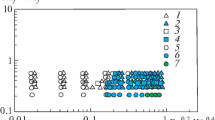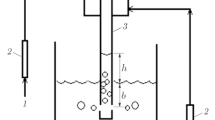Abstract
Fluid flow, heat and mass transport processes in a two-dimensional converging channel with a heated susceptor are investigated numerically for various pertinent parameters. A model is developed to analyze the impact of the transport mechanisms on the deposition process of a typical chemical vapor deposition. Discretization of the governing equations is achieved using a finite element scheme based on the Galerkin method of weighted residuals. Comparisons with previously published work on the basis of special cases are performed and found to be in excellent agreement. Various results for the streamlines, isotherms, and isoconcentrations are presented and discussed for different parametric values. The results of the present investigation show that the tilted susceptor can produce a greater deposition and a more even distribution of material than a non-tilted susceptor. Moreover, the tilted susceptor is found to suppress the effect of transverse recirculation regions inside the reactor.


















Similar content being viewed by others
Abbreviations
- A :
-
Aspect ratio, L/H
- C′:
-
Species concentration
- C :
-
Nondimensional concentration, (C′ − Co′)/(Ci′ − Co′)
- D :
-
Species diffusion coefficient
- \(\vec g\) :
-
Gravitational acceleration vector
- Gr:
-
Grashof number, g βfΔTH3/ν2
- H :
-
Channel height
- L :
-
Channel length
- L entrance :
-
Channel entrance length
- L susceptor :
-
Susceptor length
- L exit :
-
Channel exit length
- \(\overline {{\text{Nu}}} \) :
-
Average Nusselt number
- p :
-
Pressure
- P :
-
Nondimensional pressure
- Ri:
-
Richardson number, Gr/Re2
- Pr:
-
Prandtl number, ν/α
- Sc:
-
Schmidt number, ν/D
- \(\overline {{\text{Sh}}} \) :
-
Average Sherwood number
- T :
-
Temperature
- U, V:
-
Dimensionless interstitial velocity components
- u, v:
-
Interstitial velocity components
- x, y:
-
Cartesian coordinates
- X, Y:
-
Dimensionless coordinates
- α:
-
Thermal diffusivity
- βf:
-
Fluid thermal expansion coefficient
- ε:
-
Reduced temperature, (Th − Ti)/Ti
- Φ:
-
Susceptor tilt angle
- ν:
-
Kinematic viscosity
- θ:
-
Dimensionless temperature, (T − To)/(Th − To)
- ρ:
-
Density
- μ:
-
Dynamic viscosity
- h:
-
Hot
- i:
-
Inlet
- o:
-
Reference value
- s:
-
Species
References
Vossen JL, Kern W (1991) Thin film processes II. Academic, Boston
Hitchman ML, Jensen KF (1993) Chemical vapor deposition—principles and applications. Academic, London
Jones AC, O’Brien P (1997) CVD of compound semiconductors. VCH, Weinheim
Klejin CR (2000) Computational modeling of transport phenomena and detailed chemistry in chemical vapor deposition—a benchmark solution. Thin Solid Films 365:294–306
Jensen KF, Einest EO, D, Fotiadis DI (1991) Flow phenomena in chemical vapor deposition of thin films. Annu Rev Fluid Mech 23:197–232
Gage KS, Reid WH (1968) The stability of thermally stratified plane Poiseuille flow. J Fluid Mech 33:21
Luijkx JM, Platten JK, Legros CL (1981) On the existence of thermoconvective rolls, transverse to a superimposed mean Poiseuille flow. Int J Heat Mass Transfer 24:1287–1291
Evans G, Greif R (1989) A study of traveling wave instabilities in a horizontal channel flow with applications to chemical vapor deposition. Int J Heat Mass Transfer 32:895–911
Evans G, Greif R (1991) Unsteady three-dimensional mixed convection in a heated horizontal channel with applications to chemical vapor deposition. Int J Heat Mass Transfer 34:2039–2051
Mori Y, Uchida Y (1966) Forced convective heat transfer between horizontal flat plates. Int J Heat Mass Transfer 9:803–808
Chiu KC, Rosenberger F (1987) Mixed convection between horizontal plates-I. Entrance effects. Int J Heat Mass Transfer 30:1645–1654
Chiu KC, Ouazzani J, Rosenberger F (1987) Mixed convection between horizontal plates-II. Fully developed flow. Int J Heat Mass Transfer 30:1655–1662
Ingle NK, Mountziaris TJ (1994) The onset of transverse recirculations during flow of gases in horizontal ducts with differentially heated lower walls. J Fluid Mech 277:249–269
Maughan JR, Incropera FP (1990) Regions of heat transfer enhancement for laminar mixed convection in a parallel plate channel. Int J Heat Mass Transfer 33:555–570
Gau C, Huang TM, Liu CW, Aung W (1998) Mixed convection flow and heat transfer in a horizontal diverging channel with bottom wall heated. In: Proceedings of the 11th IHTC, vol 3, p 257
Chiu WK, Richards CJ, Jaluria Y (2000) Flow structure and heat transfer in a horizontal converging channel heated from below. Phys Fluids 12:2128–2136
Taylor C, Hood P (1973) A numerical solution of the Navier-Stokes equations using finite-element technique. Comput Fluids 1:73–89
Gresho PM, Lee RL, Sani RL (1980) On the time-dependent solution of the incompressible Navier-Stokes equations in two and three dimensions. In: Recent advances in numerical methods in fluids. Pineridge, Swansea
FIDAP Theoretical Manual (1990) Fluid dynamics international. Evanston, IL
Kamotani Y, Ostrach S (1976) Effect of thermal instability on thermally developing laminar channel flow. ASME J Heat Transfer 98:62–66
Acknowledgements
The grant from National Sciences and Engineering Research Council of Canada (NSERC-2002) is acknowledged and appreciated.
Author information
Authors and Affiliations
Corresponding author
Rights and permissions
About this article
Cite this article
Khanafer, K., Lightstone, M.F. Computational modeling of transport phenomena in chemical vapor deposition. Heat Mass Transfer 41, 483–494 (2005). https://doi.org/10.1007/s00231-004-0571-z
Received:
Accepted:
Published:
Issue Date:
DOI: https://doi.org/10.1007/s00231-004-0571-z




